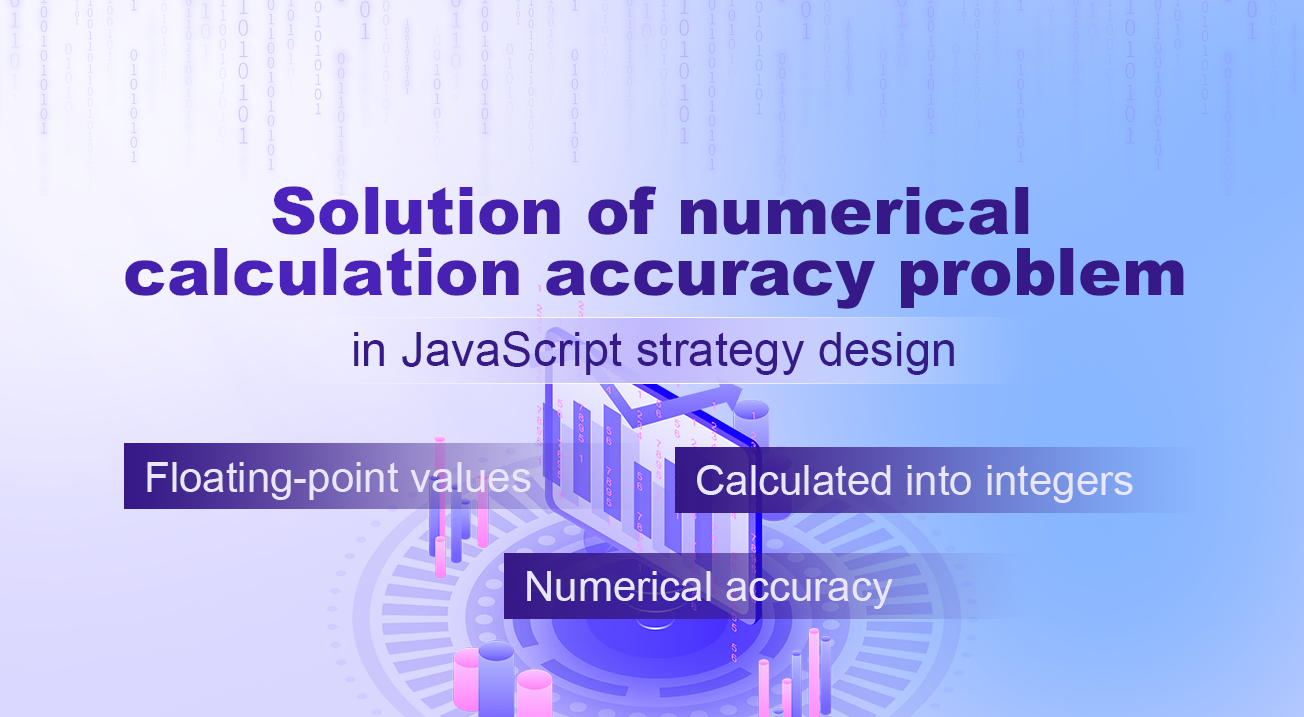Solução do problema de precisão de cálculo numérico no projeto de estratégia JavaScript
Autora:Bem-estar, Criado: 2020-07-09 11:31:01, Atualizado: 2025-01-16 21:43:49
Ao escrever estratégias JavaScript, devido a alguns problemas da própria linguagem de script, muitas vezes leva a problemas de precisão numérica nos cálculos.1 - 0.8ou0.33 * 1.1, os dados de erro serão calculados:
function main() {
var a = 1 - 0.8
Log(a)
var c = 0.33 * 1.1
Log(c)
}

Então, como resolver esses problemas?
O progresso máximo de valores de ponto flutuante é de 17 casas decimais, mas a precisão é muito pior do que os inteiros ao realizar operações; os inteiros são convertidos em decimais ao realizar operações; e ao calcular operações decimais em Java e JavaScript, ambos Primeiro converter o decimal decimal para o binário correspondente, parte do decimal não pode ser completamente convertida em binário, eis o primeiro erro. Depois que os decimais são convertidos em binário, então a operação entre o binário é realizada para obter o resultado binário.
Para resolver este problema, eu procurei algumas soluções na Internet, e testei e usei as seguintes soluções para resolver este problema:
function mathService() {
// addition
this.add = function(a, b) {
var c, d, e;
try {
c = a.toString().split(".")[1].length; // Get the decimal length of a
} catch (f) {
c = 0;
}
try {
d = b.toString().split(".")[1].length; // Get the decimal length of b
} catch (f) {
d = 0;
}
//Find e first, multiply both a and b by e to convert to integer addition, then divide by e to restore
return e = Math.pow(10, Math.max(c, d)), (this.mul(a, e) + this.mul(b, e)) / e;
}
// multiplication
this.mul = function(a, b) {
var c = 0,
d = a.toString(), // Convert to string
e = b.toString(); // ...
try {
c += d.split(".")[1].length; // c Accumulate the fractional digit length of a
} catch (f) {}
try {
c += e.split(".")[1].length; // c Accumulate the length of decimal places of b
} catch (f) {}
// Convert to integer multiplication, then divide by 10^c, move decimal point, restore, use integer multiplication without losing accuracy
return Number(d.replace(".", "")) * Number(e.replace(".", "")) / Math.pow(10, c);
}
// Subtraction
this.sub = function(a, b) {
var c, d, e;
try {
c = a.toString().split(".")[1].length; // Get the decimal length of a
} catch (f) {
c = 0;
}
try {
d = b.toString().split(".")[1].length; // Get the decimal length of b
} catch (f) {
d = 0;
}
// Same as addition
return e = Math.pow(10, Math.max(c, d)), (this.mul(a, e) - this.mul(b, e)) / e;
}
// Division
this.div = function(a, b) {
var c, d, e = 0,
f = 0;
try {
e = a.toString().split(".")[1].length;
} catch (g) {}
try {
f = b.toString().split(".")[1].length;
} catch (g) {}
// Similarly, convert to integer, after operation, restore
return c = Number(a.toString().replace(".", "")), d = Number(b.toString().replace(".", "")), this.mul(c / d, Math.pow(10, f - e));
}
}
function main() {
var obj = new mathService()
var a = 1 - 0.8
Log(a)
var b = obj.sub(1, 0.8)
Log(b)
var c = 0.33 * 1.1
Log(c)
var d = obj.mul(0.33, 1.1)
Log(d)
}

O princípio é converter os dois operandos a serem calculados em números inteiros para calcular para evitar problemas de precisão.
Desta forma, quando queremos que o programa para colocar uma ordem quando o preço de mercado mais uma precisão de preço mínimo, não temos que nos preocupar com a precisão numérica
function mathService() {
.... // Omitted
}
function main() {
var obj = new mathService()
var depth = exchange.GetDepth()
exchange.Sell(obj.add(depth.Bids[0].Price, 0.0001), depth.Bids[0].Amount, "Buy 1 order:", depth.Bids[0])
}
Os comerciantes interessados podem ler o código, compreender o processo de cálculo, convidados a fazer perguntas, aprender juntos e progredir juntos.
- Prática quantitativa das bolsas DEX (2) -- Guia do utilizador do hiperlíquido
- Práticas de quantificação da DEX Exchange ((2) -- Guia de uso do Hyperliquid
- Prática quantitativa das bolsas DEX (1) -- dYdX v4 Guia do utilizador
- Introdução à arbitragem de lead-lag em criptomoedas (3)
- Práticas de quantificação da DEX exchange ((1) -- dYdX v4 Guia de uso
- Introdução ao conjunto de Lead-Lag na moeda digital (3)
- Introdução à arbitragem de lead-lag em criptomoedas (2)
- Introdução ao suporte de Lead-Lag na moeda digital (2)
- Discussão sobre a recepção de sinais externos da plataforma FMZ: uma solução completa para receber sinais com serviço HTTP em estratégia
- Discussão da recepção de sinais externos da plataforma FMZ: estratégias para o sistema completo de recepção de sinais do serviço HTTP embutido
- Introdução à arbitragem de lead-lag em criptomoedas (1)
- Estratégia de equilíbrio e estratégia de rede
- Solução de partilha de cotações de mercado com vários robôs
- Esquema de implementação de mensagens push do robot WeChat
- Estratégias de equilíbrio e estratégias de grelha
- Estratégia de negociação gráfica de Martingale
- Python versão estratégia da comissão iceberg
- A lógica da negociação de futuros de criptomoedas
- Forma inferior da estratégia ZDZB
- Soluções de partilha de mercado multi-robô
- Modelagem e análise da volatilidade do Bitcoin com base no modelo ARMA-EGARCH
- Ensinar a encapsular uma estratégia Python em um arquivo local
- A negociação na FMEX permite a otimização do volume de encomendas Parte 2
- A negociação na FMEX permite a otimização do volume de encomendas
- Análise e Realização de Futuros de Mercadorias Gráfico da Impressão de Volume
- Desbloqueio de ordenação FMEX Optimização de volume mínimo máximo
- O bot pode enviar mensagens através de uma interface de concha
- FMEX transação de desbloqueio para o máximo de volume
- Estratégia EMV de volatilidade simples
- A mão a mão ensina-te a envelopar um documento de políticas Python de forma barata.
- Taxa de desvio estratégia de negociação BIAS